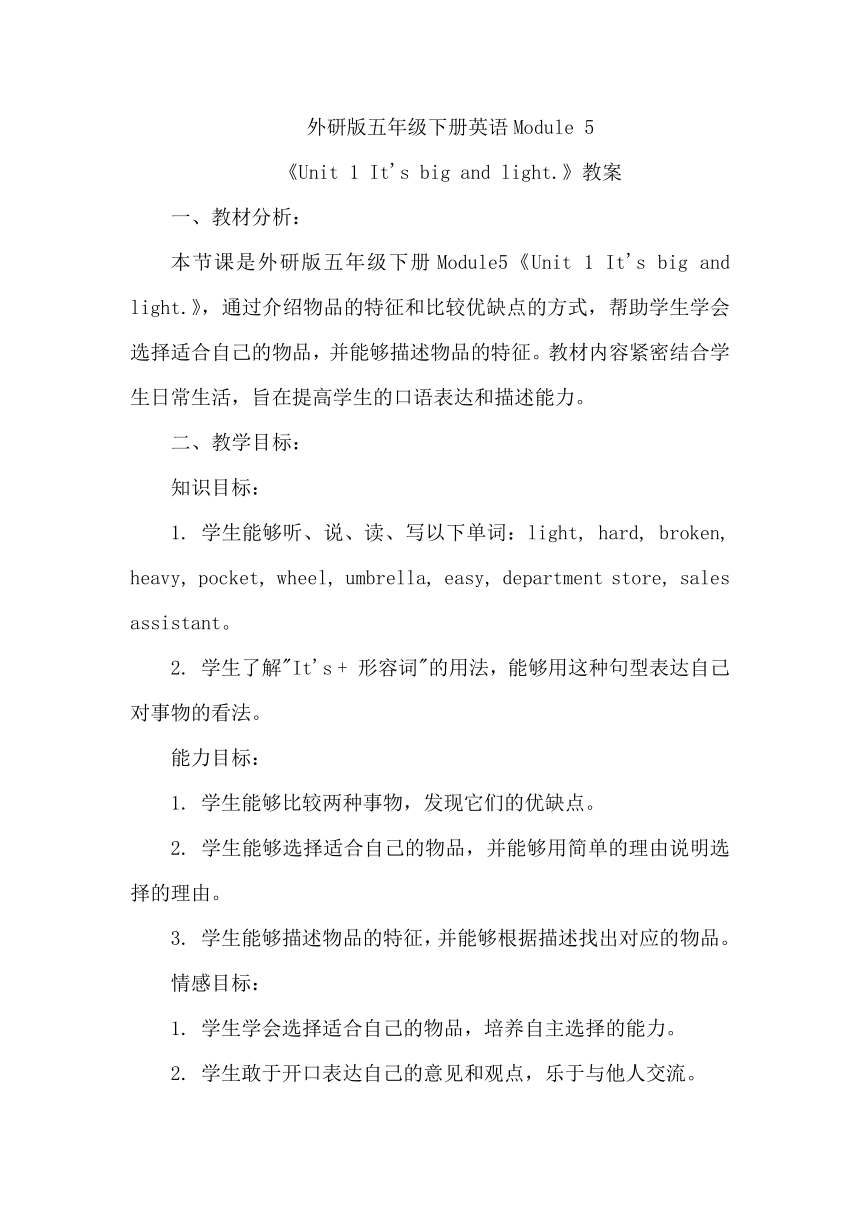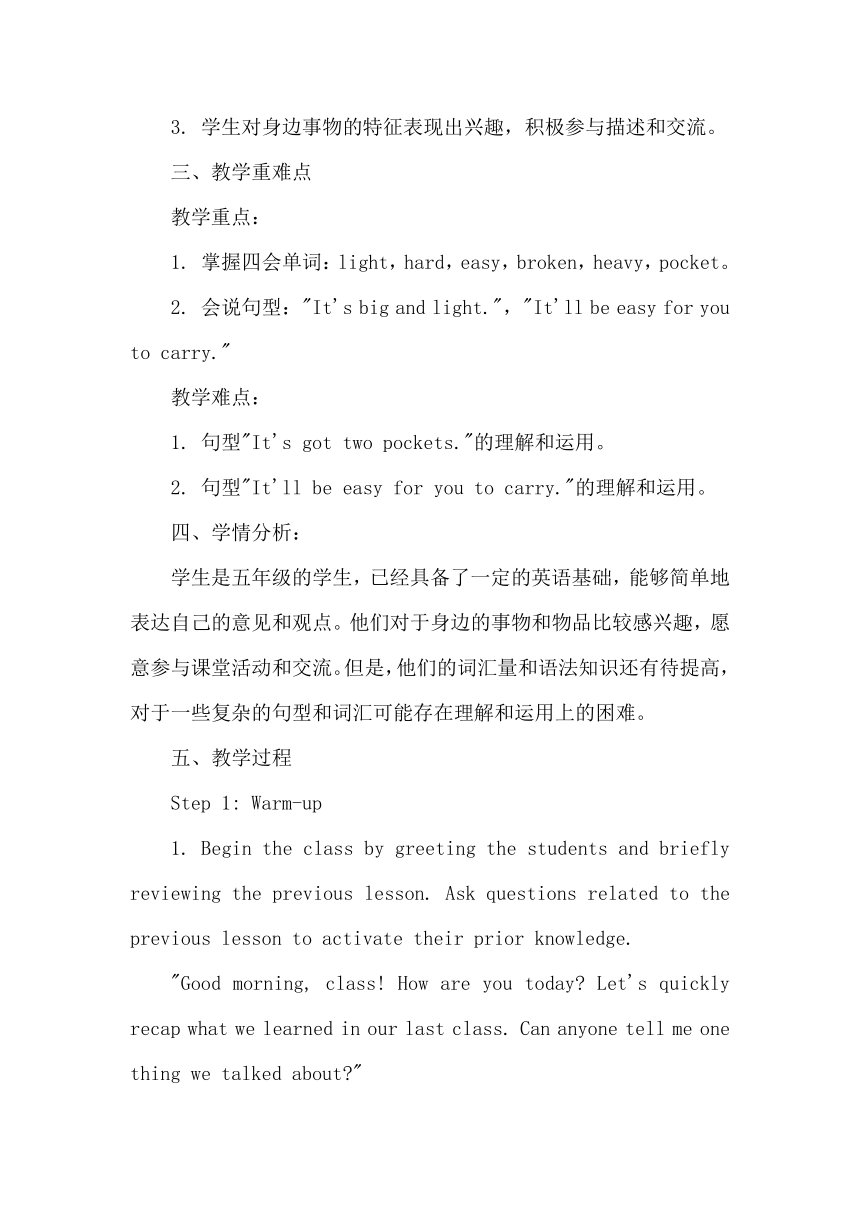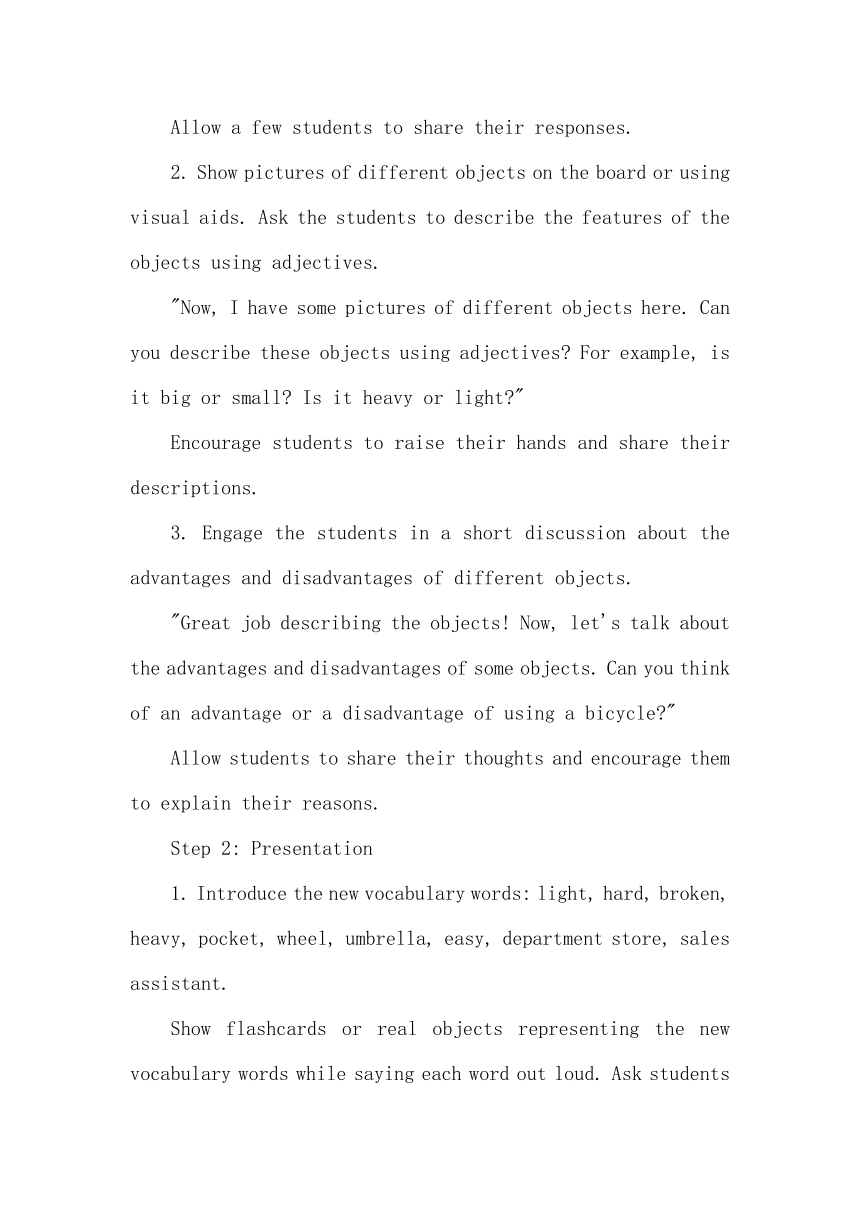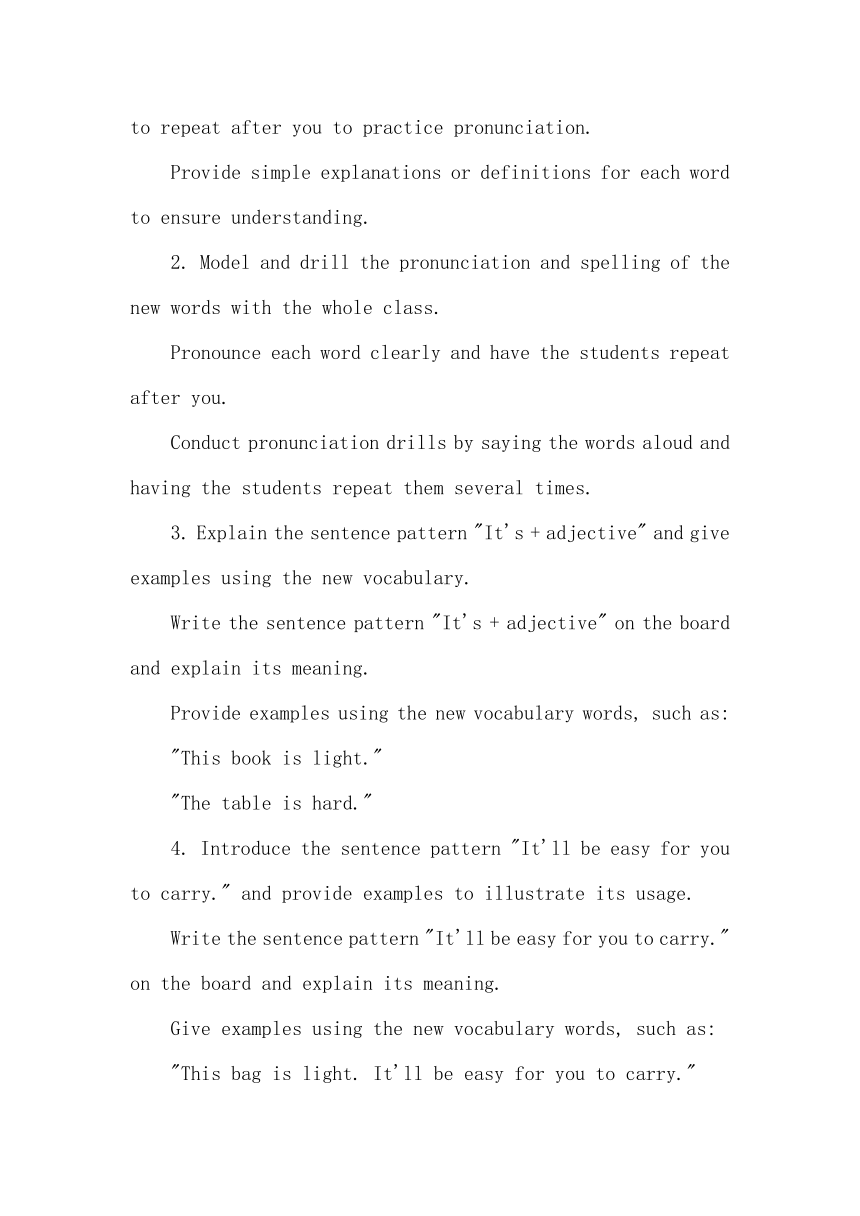Module 5 Unit 1 It's big and light.教案(含教学反思)
文档属性
| 名称 | Module 5 Unit 1 It's big and light.教案(含教学反思) |

|
|
| 格式 | docx | ||
| 文件大小 | 15.8KB | ||
| 资源类型 | 教案 | ||
| 版本资源 | 外研版(三年级起点) | ||
| 科目 | 英语 | ||
| 更新时间 | 2024-03-25 10:40:11 | ||
图片预览




文档简介
外研版五年级下册英语Module 5
《Unit 1 It's big and light.》教案
一、教材分析:
本节课是外研版五年级下册Module5《Unit 1 It's big and light.》,通过介绍物品的特征和比较优缺点的方式,帮助学生学会选择适合自己的物品,并能够描述物品的特征。教材内容紧密结合学生日常生活,旨在提高学生的口语表达和描述能力。
二、教学目标:
知识目标:
1. 学生能够听、说、读、写以下单词:light, hard, broken, heavy, pocket, wheel, umbrella, easy, department store, sales assistant。
2. 学生了解"It's + 形容词"的用法,能够用这种句型表达自己对事物的看法。
能力目标:
1. 学生能够比较两种事物,发现它们的优缺点。
2. 学生能够选择适合自己的物品,并能够用简单的理由说明选择的理由。
3. 学生能够描述物品的特征,并能够根据描述找出对应的物品。
情感目标:
1. 学生学会选择适合自己的物品,培养自主选择的能力。
2. 学生敢于开口表达自己的意见和观点,乐于与他人交流。
3. 学生对身边事物的特征表现出兴趣,积极参与描述和交流。
三、教学重难点
教学重点:
1. 掌握四会单词:light,hard,easy,broken,heavy,pocket。
2. 会说句型:"It's big and light.","It'll be easy for you to carry."
教学难点:
1. 句型"It's got two pockets."的理解和运用。
2. 句型"It'll be easy for you to carry."的理解和运用。
四、学情分析:
学生是五年级的学生,已经具备了一定的英语基础,能够简单地表达自己的意见和观点。他们对于身边的事物和物品比较感兴趣,愿意参与课堂活动和交流。但是,他们的词汇量和语法知识还有待提高,对于一些复杂的句型和词汇可能存在理解和运用上的困难。
教学过程
Step 1: Warm-up
1. Begin the class by greeting the students and briefly reviewing the previous lesson. Ask questions related to the previous lesson to activate their prior knowledge.
"Good morning, class! How are you today Let's quickly recap what we learned in our last class. Can anyone tell me one thing we talked about "
Allow a few students to share their responses.
2. Show pictures of different objects on the board or using visual aids. Ask the students to describe the features of the objects using adjectives.
"Now, I have some pictures of different objects here. Can you describe these objects using adjectives For example, is it big or small Is it heavy or light "
Encourage students to raise their hands and share their descriptions.
3. Engage the students in a short discussion about the advantages and disadvantages of different objects.
"Great job describing the objects! Now, let's talk about the advantages and disadvantages of some objects. Can you think of an advantage or a disadvantage of using a bicycle "
Allow students to share their thoughts and encourage them to explain their reasons.
Step 2: Presentation
1. Introduce the new vocabulary words: light, hard, broken, heavy, pocket, wheel, umbrella, easy, department store, sales assistant.
Show flashcards or real objects representing the new vocabulary words while saying each word out loud. Ask students to repeat after you to practice pronunciation.
Provide simple explanations or definitions for each word to ensure understanding.
2. Model and drill the pronunciation and spelling of the new words with the whole class.
Pronounce each word clearly and have the students repeat after you.
Conduct pronunciation drills by saying the words aloud and having the students repeat them several times.
3. Explain the sentence pattern "It's + adjective" and give examples using the new vocabulary.
Write the sentence pattern "It's + adjective" on the board and explain its meaning.
Provide examples using the new vocabulary words, such as:
"This book is light."
"The table is hard."
4. Introduce the sentence pattern "It'll be easy for you to carry." and provide examples to illustrate its usage.
Write the sentence pattern "It'll be easy for you to carry." on the board and explain its meaning.
Give examples using the new vocabulary words, such as:
"This bag is light. It'll be easy for you to carry."
"The box is heavy. It won't be easy for you to carry."
Step 3: Practice
1. Divide the class into pairs or small groups and distribute a set of picture cards depicting different objects to each group.
Assign each group a specific task, such as comparing two objects and discussing their advantages and disadvantages.
2. In their groups, students take turns comparing the objects and discussing their advantages and disadvantages using the target vocabulary and sentence patterns.
Encourage students to use the sentence patterns introduced earlier and express their opinions clearly.
Circulate among the groups, monitor their discussions, and provide assistance or guidance as needed.
3. Select a few groups to share their comparisons and reasons with the whole class.
Invite a representative from each group to present their findings and share their opinions.
Encourage other students to ask questions or provide additional comments.
Step 4: Consolidation
1. Play a game of "Guess the Object" to reinforce vocabulary and description skills.
Describe an object using adjectives without revealing its name, and have the students raise their hands to guess the object.
For example: "This object is small, light, and has two wheels. What is it "
Repeat the game with different objects to engage all students.
2. Show flashcards with different objects and ask students to describe their features using the target vocabulary and sentence patterns.
Display a flashcard and ask the students to describe the object using the sentence patterns and vocabulary learned.
Encourage them to use complete sentences, such as "It's big and heavy. It's a hard chair."
3. Have a class discussion on the students' preferred objects and the reasons behind their choices.
Initiate a discussion by asking questions like:
"What is your favorite object among all the ones we discussed today "
"Why do you prefer that object Can you give us some reasons "
Allow students to express their opinions and engage in a supportive conversation.
Step 5: Wrap-up and Extension
1. Recap the key vocabulary and sentence patterns learned in the lesson.
Call upon students to provide definitions or examples of the vocabulary words and sentence patterns.
Write the key vocabulary and sentence patterns on the board for visual reinforcement.
2. Assign a short writing task where students describe their favorite object using the target vocabulary and sentence patterns.
"Now, I would like you to write a short paragraph describing your favorite object using the vocabulary and sentence patterns we discussed today. Remember to use complete sentences and be descriptive!"
Provide students with writing paper or ask them to write in their notebooks.
Give them a few minutes to complete the task.
3. Encourage students to continue practicing describing objects and comparing their features in their daily life.
Conclude the lesson by encouraging students to actively use the vocabulary and sentence patterns in their everyday conversations.
Emphasize the importance of practicing language skills outside of the classroom.
Provide suggestions for additional practice, such as describing objects they encounter at home, in stores, or during outdoor activities.
六、板书设计:
Key Vocabulary:light,hard,broken,heavy,pocket,wheel,umbrella,easy,department store,sales assistant
Sentence Patterns:
It's big and light.
It'll be easy for you to carry.
It's got two pockets.
七、教学反思:
本节课通过引入新的词汇和句型,帮助学生学会描述物品的特征,并能够比较优缺点做出选择。通过小组活动和讨论,培养了学生的口语表达和交流能力。同时,通过游戏和写作任务的设计,加强了学生对所学知识的巩固和应用。教学过程中,我注意到学生对句型"It's got two pockets."的理解有些困难,下次可以提前引入相关的语法知识,帮助学生更好地理解和运用该句型。此外,教学过程中要注重培养学生的合作和沟通能力,创设积极的学习氛围,激发学生的学习兴趣。
《Unit 1 It's big and light.》教案
一、教材分析:
本节课是外研版五年级下册Module5《Unit 1 It's big and light.》,通过介绍物品的特征和比较优缺点的方式,帮助学生学会选择适合自己的物品,并能够描述物品的特征。教材内容紧密结合学生日常生活,旨在提高学生的口语表达和描述能力。
二、教学目标:
知识目标:
1. 学生能够听、说、读、写以下单词:light, hard, broken, heavy, pocket, wheel, umbrella, easy, department store, sales assistant。
2. 学生了解"It's + 形容词"的用法,能够用这种句型表达自己对事物的看法。
能力目标:
1. 学生能够比较两种事物,发现它们的优缺点。
2. 学生能够选择适合自己的物品,并能够用简单的理由说明选择的理由。
3. 学生能够描述物品的特征,并能够根据描述找出对应的物品。
情感目标:
1. 学生学会选择适合自己的物品,培养自主选择的能力。
2. 学生敢于开口表达自己的意见和观点,乐于与他人交流。
3. 学生对身边事物的特征表现出兴趣,积极参与描述和交流。
三、教学重难点
教学重点:
1. 掌握四会单词:light,hard,easy,broken,heavy,pocket。
2. 会说句型:"It's big and light.","It'll be easy for you to carry."
教学难点:
1. 句型"It's got two pockets."的理解和运用。
2. 句型"It'll be easy for you to carry."的理解和运用。
四、学情分析:
学生是五年级的学生,已经具备了一定的英语基础,能够简单地表达自己的意见和观点。他们对于身边的事物和物品比较感兴趣,愿意参与课堂活动和交流。但是,他们的词汇量和语法知识还有待提高,对于一些复杂的句型和词汇可能存在理解和运用上的困难。
教学过程
Step 1: Warm-up
1. Begin the class by greeting the students and briefly reviewing the previous lesson. Ask questions related to the previous lesson to activate their prior knowledge.
"Good morning, class! How are you today Let's quickly recap what we learned in our last class. Can anyone tell me one thing we talked about "
Allow a few students to share their responses.
2. Show pictures of different objects on the board or using visual aids. Ask the students to describe the features of the objects using adjectives.
"Now, I have some pictures of different objects here. Can you describe these objects using adjectives For example, is it big or small Is it heavy or light "
Encourage students to raise their hands and share their descriptions.
3. Engage the students in a short discussion about the advantages and disadvantages of different objects.
"Great job describing the objects! Now, let's talk about the advantages and disadvantages of some objects. Can you think of an advantage or a disadvantage of using a bicycle "
Allow students to share their thoughts and encourage them to explain their reasons.
Step 2: Presentation
1. Introduce the new vocabulary words: light, hard, broken, heavy, pocket, wheel, umbrella, easy, department store, sales assistant.
Show flashcards or real objects representing the new vocabulary words while saying each word out loud. Ask students to repeat after you to practice pronunciation.
Provide simple explanations or definitions for each word to ensure understanding.
2. Model and drill the pronunciation and spelling of the new words with the whole class.
Pronounce each word clearly and have the students repeat after you.
Conduct pronunciation drills by saying the words aloud and having the students repeat them several times.
3. Explain the sentence pattern "It's + adjective" and give examples using the new vocabulary.
Write the sentence pattern "It's + adjective" on the board and explain its meaning.
Provide examples using the new vocabulary words, such as:
"This book is light."
"The table is hard."
4. Introduce the sentence pattern "It'll be easy for you to carry." and provide examples to illustrate its usage.
Write the sentence pattern "It'll be easy for you to carry." on the board and explain its meaning.
Give examples using the new vocabulary words, such as:
"This bag is light. It'll be easy for you to carry."
"The box is heavy. It won't be easy for you to carry."
Step 3: Practice
1. Divide the class into pairs or small groups and distribute a set of picture cards depicting different objects to each group.
Assign each group a specific task, such as comparing two objects and discussing their advantages and disadvantages.
2. In their groups, students take turns comparing the objects and discussing their advantages and disadvantages using the target vocabulary and sentence patterns.
Encourage students to use the sentence patterns introduced earlier and express their opinions clearly.
Circulate among the groups, monitor their discussions, and provide assistance or guidance as needed.
3. Select a few groups to share their comparisons and reasons with the whole class.
Invite a representative from each group to present their findings and share their opinions.
Encourage other students to ask questions or provide additional comments.
Step 4: Consolidation
1. Play a game of "Guess the Object" to reinforce vocabulary and description skills.
Describe an object using adjectives without revealing its name, and have the students raise their hands to guess the object.
For example: "This object is small, light, and has two wheels. What is it "
Repeat the game with different objects to engage all students.
2. Show flashcards with different objects and ask students to describe their features using the target vocabulary and sentence patterns.
Display a flashcard and ask the students to describe the object using the sentence patterns and vocabulary learned.
Encourage them to use complete sentences, such as "It's big and heavy. It's a hard chair."
3. Have a class discussion on the students' preferred objects and the reasons behind their choices.
Initiate a discussion by asking questions like:
"What is your favorite object among all the ones we discussed today "
"Why do you prefer that object Can you give us some reasons "
Allow students to express their opinions and engage in a supportive conversation.
Step 5: Wrap-up and Extension
1. Recap the key vocabulary and sentence patterns learned in the lesson.
Call upon students to provide definitions or examples of the vocabulary words and sentence patterns.
Write the key vocabulary and sentence patterns on the board for visual reinforcement.
2. Assign a short writing task where students describe their favorite object using the target vocabulary and sentence patterns.
"Now, I would like you to write a short paragraph describing your favorite object using the vocabulary and sentence patterns we discussed today. Remember to use complete sentences and be descriptive!"
Provide students with writing paper or ask them to write in their notebooks.
Give them a few minutes to complete the task.
3. Encourage students to continue practicing describing objects and comparing their features in their daily life.
Conclude the lesson by encouraging students to actively use the vocabulary and sentence patterns in their everyday conversations.
Emphasize the importance of practicing language skills outside of the classroom.
Provide suggestions for additional practice, such as describing objects they encounter at home, in stores, or during outdoor activities.
六、板书设计:
Key Vocabulary:light,hard,broken,heavy,pocket,wheel,umbrella,easy,department store,sales assistant
Sentence Patterns:
It's big and light.
It'll be easy for you to carry.
It's got two pockets.
七、教学反思:
本节课通过引入新的词汇和句型,帮助学生学会描述物品的特征,并能够比较优缺点做出选择。通过小组活动和讨论,培养了学生的口语表达和交流能力。同时,通过游戏和写作任务的设计,加强了学生对所学知识的巩固和应用。教学过程中,我注意到学生对句型"It's got two pockets."的理解有些困难,下次可以提前引入相关的语法知识,帮助学生更好地理解和运用该句型。此外,教学过程中要注重培养学生的合作和沟通能力,创设积极的学习氛围,激发学生的学习兴趣。
同课章节目录
- Module 1
- Unit 1 We lived in a small house.
- Unit 2 She didn't have a television.
- Module 2
- Unit 1 She learnt English.
- Unit 2 Mr Li was a teacher.
- Module 3
- Unit 1 She had eggs and sausages.
- Unit 2 Sam ate four hamburgers.
- Module 4
- Unit 1 Let's make a home library.
- Unit 2 We can find information from books and CDs.
- Module 5
- Unit 1 It's big and light.
- Unit 2 It's too big for you.
- Module 6
- Unit 1 I went there last year.
- Unit 2 She visited the Tianchi Lake.
- Module 7
- Unit 1 My father goes to work at eight o'clock eve
- Unit 2 I'll be home at seven o'clock.
- Module 8
- Unit 1 Will you help me?
- Unit 2 I made a kite.
- Module 9
- Unit 1 We laughed a lot.
- Unit 2 Mum bought new T-shirts for you.
- Module 10
- Unit 1 Where are you going to go?
- Unit 2 I'm in New York now.
- Review Module
- Unit 1
- Unit 2
